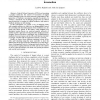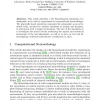21 search results - page 3 / 5 » Controlling swimming and crawling in a fish robot using a ce... |
ICRA
2005
IEEE
13 years 11 months ago
2005
IEEE
– We describe in detail the behavior of an inhibitory Central Pattern Generator (CPG) network for robot control. A four-neuron, mutual inhibitory network forms the basic coordina...
ICRA
2005
IEEE
13 years 11 months ago
2005
IEEE
- Polychaete annelid worms provide a biological paradigm of versatile locomotion and effective motion control, adaptable to a large variety of unstructured environmental conditions...
ICRA
2008
IEEE
13 years 11 months ago
2008
IEEE
— Central Pattern Generators (CPGs) are becoming a popular model for the control of locomotion of legged robots. Biological CPGs are neural networks responsible for the generatio...
VW
2000
Springer
13 years 8 months ago
2000
Springer
This article describes a 3D biomechanical simulation of a salamander to be used in experiments in computational neuroethology. The physically-based simulation represents the salama...
ICRA
2000
IEEE
13 years 9 months ago
2000
IEEE
We are trying to induce a quadruped robot to walk dynamically on irregular terrain by using a neural system model. In this paper, we integrate several reflexes such as stretch ref...


